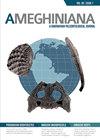Late Pleistocene Palaeoenvironmental Variations from Marine Isotope Stages 5 and 4: Small Mammals at Artazu VIII Site (Arrasate, Northern Iberian Peninsula)
IF 1.5
4区 地球科学
Q3 PALEONTOLOGY
引用次数: 0
Abstract
Abstract. Sites corresponding to Marine Isotope Stage MIS 5c and MIS 4 like Artazu VIII, with a continental record but no hominin imprints or carnivore activities, are very scarce in the Iberian Peninsula. The Artazu VIII cave fill (Arrasate, northern Spain) was discovered in 2013 and is presented here for the first time, including detailed stratigraphic and sedimentological descriptions of the differentiated 12 levels, as well as an ordered chronology of most levels, covering at least 36.000 years. In addition, the small mammal assemblage yielded a total of 8,129 identifiable skeletal remains corresponding to 14 taxa. The conditions inferred from the ecological preferences of the small mammal associations have been correlated with four different stages and substages from MIS 5c to MIS 4 in which the woodland mass expanded and retreated, depending on the relative temperature and humidity in each period. Finally, considering the species variability and estimated palaeoenvironment, a comparison with the NGRIP δ18O curve and other sites with the same chronology has been performed, showing that Artazu VIII is one of the few deposits attributable to the Marine Isotopic Stages previously mentioned and the only one that correlates to the Greenland Interstadial 18 from the Iberian Peninsula.晚更新世海洋同位素阶段5和4的古环境变化:北伊比利亚半岛Artazu VIII遗址(Arrasate)的小型哺乳动物
摘要与海洋同位素阶段MIS 5c和MIS 4相对应的遗址,如Artazu VIII,具有大陆记录,但没有人族印记或食肉动物活动,在伊比利亚半岛非常罕见。Artazu VIII洞穴填充物(西班牙北部Arrasate)于2013年被发现,并首次在这里展示,包括对12个不同层次的详细地层和沉积学描述,以及大多数层次的有序年代学,涵盖至少3.6万年。此外,小型哺乳动物组合共产生了8129个可识别的骨骼遗骸,对应于14个分类群。根据小哺乳动物群落的生态偏好推断出的条件与从MIS 5c到MIS 4的四个不同阶段和亚阶段相关,在这些阶段和亚阶段中,林地面积的扩大和缩小取决于每个时期的相对温度和湿度。最后,考虑到物种变异和估算的古环境,与NGRIP δ18O曲线和其他具有相同年代学的地点进行了比较,表明Artazu VIII是少数可归因于上述海洋同位素阶段的矿床之一,也是唯一与来自伊比利亚半岛的格陵兰Interstadial 18相关的矿床。
本文章由计算机程序翻译,如有差异,请以英文原文为准。
求助全文
约1分钟内获得全文
求助全文
来源期刊

Ameghiniana
地学-古生物学
CiteScore
2.50
自引率
10.00%
发文量
21
期刊介绍:
Ameghiniana is a bimonthly journal that publishes original contributions on all disciplines related to paleontology, with a special focus on the paleontology of Gondwana and the biotic history of the southern hemisphere. Published yearly since 1957, it has undoubtedly become the main palaeontological publication from Latin America. Ameghiniana has recently broadened its editorial board, reorganized its production process, and increased to a bimonthly frequency, which resulted in a significant decrease in the turn around time.
 求助内容:
求助内容: 应助结果提醒方式:
应助结果提醒方式:


